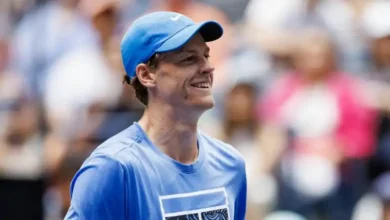Jannik Sinner sends warning to Novak Djokovic after winning US Open

In the world of tennis, a significant shift is underway as a new generation of players begins to make its mark. At the forefront of this transformation is Jannik Sinner, whose recent victory at the US Open has solidified his status as one of the sport’s brightest stars. This win, his second Grand Slam title of 2024 following his triumph at the Australian Open, is a testament to his remarkable talent and unwavering dedication.
Sinner’s triumph at the US Open is particularly noteworthy as it marks the first time he has won both hardcourt Grand Slam titles in the same season. At just 23 years old, he has achieved what only a handful of players have managed in the Open Era. His dual victories highlight not only his exceptional skill on the court but also his ability to perform consistently at the highest levels of the sport.
The significance of Sinner’s success extends beyond his personal achievements. His victories signal a broader shift in men’s tennis, as the sport witnesses a changing of the guard. For the first time since 1993, all four Grand Slam titles in a single year have been claimed by players aged 23 or younger. This marks a departure from the dominance of the “Big Three”—Novak Djokovic, Rafael Nadal, and Roger Federer—who had long been the standard-bearers of the sport.
Sinner’s rise to prominence is emblematic of this new era. His performance throughout the season, including his recent hardcourt double, underscores the emergence of a new generation of players who are now stepping into the limelight. This shift is not only reshaping the competitive landscape but also injecting fresh energy and excitement into the sport.
In his reflections on his recent success, Sinner expressed a keen awareness of the continuous effort required to maintain and build upon his achievements. He emphasized that despite his current success, there is always room for improvement. His comments reveal a deep commitment to refining his skills and addressing areas where he can enhance his performance. Sinner’s focus on constant improvement and adaptation highlights the evolving nature of tennis and the demands placed on top players.
Sinner’s outlook on the sport also touches on the importance of new rivalries and emerging talent. He welcomed the changes in the tennis landscape, noting that these developments contribute to the overall growth and dynamism of the sport. The introduction of new champions and the evolution of rivalries provide players like Sinner with opportunities to push their limits and elevate their game.
As Sinner continues to make strides in his career, his story reflects a broader narrative of change within tennis. His achievements are not only a testament to his own abilities but also a reflection of the evolving nature of the sport. The emergence of new stars and the shifting dynamics among players signal an exciting future for tennis, one where fresh talent and evolving rivalries promise to shape the game in new and exciting ways.
Jannik Sinner’s journey is a compelling example of the evolving landscape of tennis. His success and his thoughtful approach to improvement underscore the vibrant and dynamic nature of the sport as it transitions into a new era. As he continues to push boundaries and set new standards, Sinner is poised to play a pivotal role in shaping the future of tennis.



